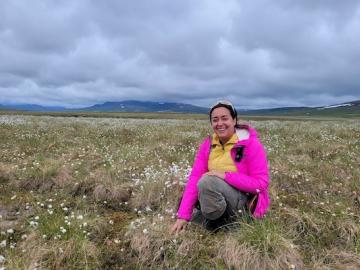Filter News
Area of Research
- (-) Biology and Environment (56)
- (-) Fusion and Fission (15)
- Advanced Manufacturing (8)
- Biological Systems (1)
- Biology and Soft Matter (1)
- Building Technologies (3)
- Clean Energy (109)
- Climate and Environmental Systems (2)
- Computational Biology (1)
- Computational Engineering (1)
- Computer Science (9)
- Electricity and Smart Grid (1)
- Functional Materials for Energy (2)
- Fusion Energy (6)
- Isotopes (3)
- Materials (98)
- Materials for Computing (6)
- National Security (30)
- Neutron Science (37)
- Nuclear Science and Technology (11)
- Quantum information Science (3)
- Renewable Energy (1)
- Supercomputing (70)
- Transportation Systems (1)
News Topics
- 3-D Printing/Advanced Manufacturing (3)
- Advanced Reactors (2)
- Artificial Intelligence (3)
- Big Data (1)
- Bioenergy (16)
- Biology (26)
- Biomedical (2)
- Biotechnology (3)
- Buildings (1)
- Chemical Sciences (6)
- Clean Water (2)
- Climate Change (16)
- Composites (2)
- Computer Science (4)
- Coronavirus (2)
- Critical Materials (1)
- Cybersecurity (1)
- Decarbonization (9)
- Energy Storage (6)
- Environment (26)
- Exascale Computing (1)
- Fossil Energy (1)
- Frontier (1)
- Fusion (6)
- Grid (3)
- High-Performance Computing (4)
- Hydropower (5)
- ITER (2)
- Machine Learning (3)
- Materials (4)
- Materials Science (4)
- Mercury (1)
- Microscopy (6)
- Nanotechnology (2)
- National Security (1)
- Net Zero (1)
- Neutron Science (1)
- Nuclear Energy (9)
- Partnerships (4)
- Physics (1)
- Polymers (1)
- Security (2)
- Simulation (1)
- Space Exploration (1)
- Summit (2)
- Sustainable Energy (13)
- Transformational Challenge Reactor (1)
- Transportation (2)
Media Contacts

A new paper published in Nature Communications adds further evidence to the bradykinin storm theory of COVID-19’s viral pathogenesis — a theory that was posited two years ago by a team of researchers at the Department of Energy’s Oak Ridge National Laboratory.

When Hurricane Maria battered Puerto Rico in 2017, winds snapped trees and destroyed homes, while heavy rains transformed streets into rivers. But after the storm passed, the human toll continued to grow as residents struggled without electricity for months. Five years later, power outages remain long and frequent.

With wildfires increasing in scope and intensity around the world, Fernanda Santos’ research into how such calamities affect soil carbon storage has taken on new urgency.

Researchers in the geothermal energy industry are joining forces with fusion experts at ORNL to repurpose gyrotron technology, a tool used in fusion. Gyrotrons produce high-powered microwaves to heat up fusion plasmas.

Global carbon emissions from inland waters such as lakes, rivers, streams and ponds are being undercounted by about 13% and will likely continue to rise given climate events and land use changes, ORNL scientists found.

Five technologies invented by scientists at the Department of Energy’s Oak Ridge National Laboratory have been selected for targeted investment through ORNL’s Technology Innovation Program.

Oak Ridge National Laboratory physicist Elizabeth “Libby” Johnson (1921-1996), one of the world’s first nuclear reactor operators, standardized the field of criticality safety with peers from ORNL and Los Alamos National Laboratory.

Scientists at ORNL have created a miniaturized environment to study the ecosystem around poplar tree roots for insights into plant health and soil carbon sequestration.

A team of scientists led by Oak Ridge National Laboratory developed a theory that thylakoids, membrane networks key to plant photosynthesis, also function as a defense mechanism to harsh growing conditions, which could aid the development of hardier plants.

Chemical and environmental engineer Samarthya Bhagia is focused on achieving carbon neutrality and a circular economy by designing new plant-based materials for a range of applications from energy storage devices and sensors to environmentally friendly bioplastics.




